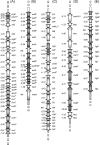FNR is a global regulator of virulence and anaerobic metabolism in Salmonella enterica serovar Typhimurium (ATCC 14028s)
- PMID: 17220229
- PMCID: PMC1899381
- DOI: 10.1128/JB.00726-06
FNR is a global regulator of virulence and anaerobic metabolism in Salmonella enterica serovar Typhimurium (ATCC 14028s)
Abstract
Salmonella enterica serovar Typhimurium must successfully transition the broad fluctuations in oxygen concentrations encountered in the host. In Escherichia coli, FNR is one of the main regulatory proteins involved in O2 sensing. To assess the role of FNR in serovar Typhimurium, we constructed an isogenic fnr mutant in the virulent wild-type strain (ATCC 14028s) and compared their transcriptional profiles and pathogenicities in mice. Here, we report that, under anaerobic conditions, 311 genes (6.80% of the genome) are regulated directly or indirectly by FNR; of these, 87 genes (28%) are poorly characterized. Regulation by FNR in serovar Typhimurium is similar to, but distinct from, that in E. coli. Thus, genes/operons involved in aerobic metabolism, NO. detoxification, flagellar biosynthesis, motility, chemotaxis, and anaerobic carbon utilization are regulated by FNR in a fashion similar to that in E. coli. However, genes/operons existing in E. coli but regulated by FNR only in serovar Typhimurium include those coding for ethanolamine utilization, a universal stress protein, a ferritin-like protein, and a phosphotransacetylase. Interestingly, Salmonella-specific genes/operons regulated by FNR include numerous virulence genes within Salmonella pathogenicity island 1 (SPI-1), newly identified flagellar genes (mcpAC, cheV), and the virulence operon (srfABC). Furthermore, the role of FNR as a positive regulator of motility, flagellar biosynthesis, and pathogenesis was confirmed by showing that the mutant is nonmotile, lacks flagella, is attenuated in mice, and does not survive inside macrophages. The inability of the mutant to survive inside macrophages is likely due to its sensitivity to the reactive oxygen species generated by NADPH phagocyte oxidase.
Figures








Similar articles
-
Analysis of the ArcA regulon in anaerobically grown Salmonella enterica sv. Typhimurium.BMC Microbiol. 2011 Mar 21;11:58. doi: 10.1186/1471-2180-11-58. BMC Microbiol. 2011. PMID: 21418628 Free PMC article.
-
Comparative proteomic analysis of Salmonella Typhimurium wild type and its isogenic fnr null mutant during anaerobiosis reveals new insight into bacterial metabolism and virulence.Microb Pathog. 2020 Mar;140:103936. doi: 10.1016/j.micpath.2019.103936. Epub 2019 Dec 18. Microb Pathog. 2020. PMID: 31862389
-
Proteomic Analysis of FNR-Regulated Anaerobiosis in Salmonella Typhimurium.J Am Soc Mass Spectrom. 2019 Jun;30(6):1001-1012. doi: 10.1007/s13361-019-02145-2. Epub 2019 Mar 22. J Am Soc Mass Spectrom. 2019. PMID: 30903387
-
FNR and its role in oxygen-regulated gene expression in Escherichia coli.FEMS Microbiol Rev. 1990 Aug;6(4):399-428. doi: 10.1111/j.1574-6968.1990.tb04109.x. FEMS Microbiol Rev. 1990. PMID: 2248796 Review.
-
Oxygen regulated gene expression in Escherichia coli: control of anaerobic respiration by the FNR protein.Antonie Van Leeuwenhoek. 1991 Feb;59(2):65-76. doi: 10.1007/BF00445650. Antonie Van Leeuwenhoek. 1991. PMID: 1854188 Review.
Cited by
-
Anaerobiosis, a neglected factor in phage-bacteria interactions.Appl Environ Microbiol. 2023 Dec 21;89(12):e0149123. doi: 10.1128/aem.01491-23. Epub 2023 Nov 15. Appl Environ Microbiol. 2023. PMID: 37966212 Free PMC article.
-
Strategies of Pathogens to Escape from NO-Based Host Defense.Antioxidants (Basel). 2022 Nov 3;11(11):2176. doi: 10.3390/antiox11112176. Antioxidants (Basel). 2022. PMID: 36358549 Free PMC article. Review.
-
Alterations in the Transcriptional Landscape Allow Differential Desiccation Tolerance in Clinical Cronobacter sakazakii.Appl Environ Microbiol. 2021 Nov 24;87(24):e0083021. doi: 10.1128/AEM.00830-21. Epub 2021 Oct 13. Appl Environ Microbiol. 2021. PMID: 34644165 Free PMC article.
-
Integrating global regulatory input into the Salmonella pathogenicity island 1 type III secretion system.Genetics. 2012 Jan;190(1):79-90. doi: 10.1534/genetics.111.132779. Epub 2011 Oct 20. Genetics. 2012. PMID: 22021388 Free PMC article.
-
Multiple single-cell genomes provide insight into functions of uncultured Deltaproteobacteria in the human oral cavity.PLoS One. 2013;8(3):e59361. doi: 10.1371/journal.pone.0059361. Epub 2013 Mar 26. PLoS One. 2013. PMID: 23555659 Free PMC article.
References
-
- Adkins, J. N., H. M. Mottaz, A. D. Norbeck, J. K. Gustin, J. Rue, T. R. W. Clauss, S. O. Purvine, K. D. Rodland, F. Heffron, and R. D. Smith. 2006. Analysis of the Salmonella typhimurium proteome through environmental response toward infectious conditions. Mol. Cell. Proteomics 5:1450-1461. - PubMed
-
- Bajaj, V., R. L. Lucas, C. Hwang, and C. A. Lee. 1996. Co-ordinate regulation of Salmonella typhimurium invasion genes by environmental and regulatory factors is mediated by control of hilA expression. Mol. Microbiol. 22:703-714. - PubMed
-
- Bang, I.-S., L. Liu, A. Vazquez-Torres, M.-L. Crouch, J. S. Stamler, and F. C. Fang. 2006. Maintenance of nitric oxide and redox homeostasis by the Salmonella flavohemoglobin Hmp. J. Biol. Chem. 281:28039-28047. - PubMed
Publication types
MeSH terms
Substances
Associated data
- Actions
Grants and funding
- R21 AI048622/AI/NIAID NIH HHS/United States
- R21 AI057733/AI/NIAID NIH HHS/United States
- R01AI022933/AI/NIAID NIH HHS/United States
- R01 AI034829/AI/NIAID NIH HHS/United States
- R01 AI048622/AI/NIAID NIH HHS/United States
- R01AI034829/AI/NIAID NIH HHS/United States
- R01AI52237/AI/NIAID NIH HHS/United States
- R01 AI022933/AI/NIAID NIH HHS/United States
- R56 AI054959/AI/NIAID NIH HHS/United States
- RR16082/RR/NCRR NIH HHS/United States
- R01 AI052237/AI/NIAID NIH HHS/United States
- R01 AI054959/AI/NIAID NIH HHS/United States
- K01 RR016082/RR/NCRR NIH HHS/United States
- R21AI057733/AI/NIAID NIH HHS/United States
- AI48622/AI/NIAID NIH HHS/United States
- AI054959/AI/NIAID NIH HHS/United States
LinkOut - more resources
Full Text Sources
Other Literature Sources
Molecular Biology Databases

